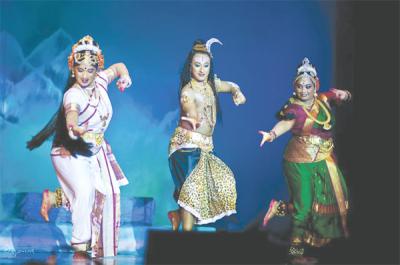The School of Performing Arts of Mahatma Gandhi Institute presented recently “Ganga Gauri Samvaadam”, a kuchipudi Dance Ballet beautifully choreographed by guru shri Bhagavathula Sethuram, Head, Dance Department Pitti Shriramulu Telugu University, Hyderabad, India.
The ballet was in kuchipudi form of Indian Classical Dance which has different music, instruments, gestures and gatis from other forms of Indian classical dance. It was a real premier by the artists of MGI. Let me succinctly give a brief on Kuchipudi dance. It is named after the village of its birth Kuseelavapuri, a quiet village about 52 miles away from Vijayawada in Andhra Pradesh. Kuchipudi is the colloqualised form of the Sanskrit word Kuseelavapuri, meaning « the abode of the Kuseelavas. » Kuseelavas were bands of actors wandering from place to place around the villages of Andhra.
Dancing has its place in all societies and yet the phenomenon of dance has been oddly neglected by most anthropologists. It is claimed that, in a very important sense, society creates dance, and it is to society and not just to the dancer’s experience that we must turn to understand its significance. Performance has meaning within social process. The word “performance” should not be taken for granted. Performance developed as a topical interest in anthropology as from the 1970s. Scholars within the disciplines of anthropology, anthropological linguistics and folklore worked together to contribute to a view of the performance as a way to examine social processes.
The anthropological analysis of dance can be approached in a variety of ways. While watching the ballet I felt that dancing is presented as a controlled emotional outlet whose form reflects cosmology; as a creative experience that draws adolescent girls into the adult world; as an extension of speech and gesture that adds further levels of meaning to formal occasions; as a strategy for orchestrating the climax of a successful exchange; as a challenge to the power of elders that generates an alternative reality, as a communial response to crisis that recreates order out of confusion; and as a sequence of transformation that periodically resolves an inherent social dilemma. Dance is not just a static representation of history, not just a repository of meaning, but a producer of meaning each time it is produced – not just a living mirror of a culture, but a shaping part of culture, a power within the culture.
Before the start of the ballet the usual ritualized lighting ceremony of lamps was conducted but the wicks of the lamps were so weak that very soon they breathed their last despite attempts of rescue made during the performance. This action was very obvious and spoiled the rhythm of the ballet. The down podium decorum with huge pots of flowers was a bit depressing otherwise the art piece crafted by the Fine Arts Department needs to be praised. These trivial details are imperative as in such performances there is an energy that flows from the stage to the audience. It prepares the mind to watch and the performers to perform as in a football playground.
The Ballet starts. Gradually with the musical composition and the description of various facets of Shiva, the amazing inner resilience has come to the fore. The building up is slow and cautious, but once the dancers reach crescendo, it invariably communicates a deep feeling of faith and adoration, coupled with the yearning of the human for the divine. And thanks to the great guru and performing artists, it has, after its initial revival gathered unprecedented momentum. One of the most beautiful, subtle, sophisticated, and graceful dance forms is performed according to the most delicate nuances of a musical piece, through the vehicle of a body.
The movements in Kuchipudi are more relaxed, rounded, lively and quick-paced in comparison with Bharatnatyam. Esther Sherman from America, also known as Ragini Devi, and a great pioneer in the revival of Indian classical dances wrote, “In Kuchipudi nritya, Indian classical dancing has found a fluent medium of dramatic expression in dance, having an extensive vocabulary of gestures for conveying narrative and dramatic themes, moods, and states in the Natya Shastra traditions”.
There is reciprocity between gender and dance, and how culturally accepted gender roles can either be emphasized or reinterpreted through movement and costume. This choreography was well coordinated except for a slight problem of synchronization among the artists. Overall they deserve a bravo.
The “kuchipudi” Dance Ballet
- Publicité -
EN CONTINU ↻
- Publicité -

